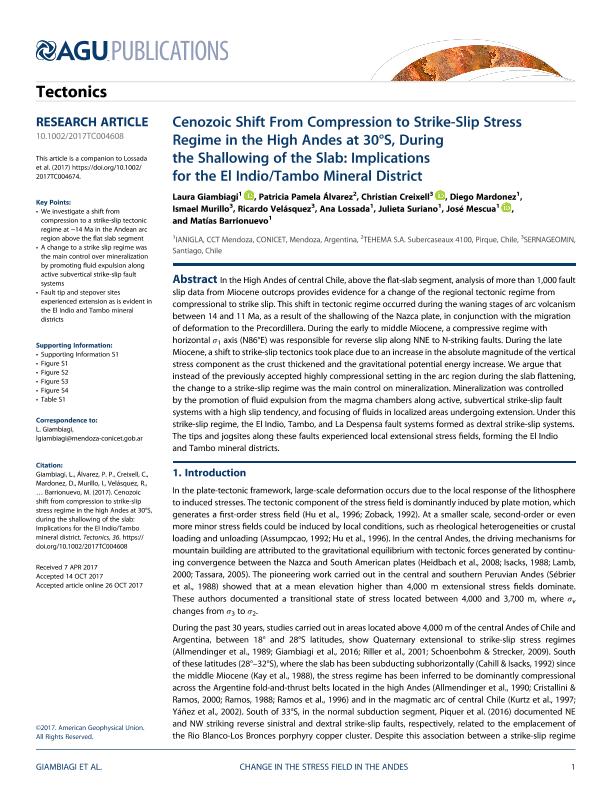Artículo
Cenozoic Shift From Compression to Strike-Slip Stress Regime in the High Andes at 30°S, During the Shallowing of the Slab: Implications for the El Indio/Tambo Mineral District
Giambiagi, Laura Beatriz ; Álvarez, Patricia Pamela; Creixell, Christian; Mardonez Catalán, Diego José
; Álvarez, Patricia Pamela; Creixell, Christian; Mardonez Catalán, Diego José ; Murillo, Ismael; Velásquez, Ricardo; Lossada, Ana Clara
; Murillo, Ismael; Velásquez, Ricardo; Lossada, Ana Clara ; Suriano, Julieta
; Suriano, Julieta ; Mescua, Jose Francisco
; Mescua, Jose Francisco ; Barrionuevo, Matías
; Barrionuevo, Matías
 ; Álvarez, Patricia Pamela; Creixell, Christian; Mardonez Catalán, Diego José
; Álvarez, Patricia Pamela; Creixell, Christian; Mardonez Catalán, Diego José ; Murillo, Ismael; Velásquez, Ricardo; Lossada, Ana Clara
; Murillo, Ismael; Velásquez, Ricardo; Lossada, Ana Clara ; Suriano, Julieta
; Suriano, Julieta ; Mescua, Jose Francisco
; Mescua, Jose Francisco ; Barrionuevo, Matías
; Barrionuevo, Matías
Fecha de publicación:
28/11/2017
Editorial:
American Geophysical Union
Revista:
Tectonics
ISSN:
0278-7407
Idioma:
Inglés
Tipo de recurso:
Artículo publicado
Clasificación temática:
Resumen
In the High Andes of central Chile, above the flat-slab segment, analysis of more than 1,000 fault slip data from Miocene outcrops provides evidence for a change of the regional tectonic regime from compressional to strike slip. This shift in tectonic regime occurred during the waning stages of arc volcanism between 14 and 11 Ma, as a result of the shallowing of the Nazca plate, in conjunction with the migration of deformation to the Precordillera. During the early to middle Miocene, a compressive regime with horizontal σ1 axis (N86°E) was responsible for reverse slip along NNE to N-striking faults. During the late Miocene, a shift to strike-slip tectonics took place due to an increase in the absolute magnitude of the vertical stress component as the crust thickened and the gravitational potential energy increase. We argue that instead of the previously accepted highly compressional setting in the arc region during the slab flattening, the change to a strike-slip regime was the main control on mineralization. Mineralization was controlled by the promotion of fluid expulsion from the magma chambers along active, subvertical strike-slip fault systems with a high slip tendency, and focusing of fluids in localized areas undergoing extension. Under this strike-slip regime, the El Indio, Tambo, and La Despensa fault systems formed as dextral strike-slip systems. The tips and jogsites along these faults experienced local extensional stress fields, forming the El Indio and Tambo mineral districts.
Palabras clave:
Andes
,
El Indio Mine
,
Stress Field
Archivos asociados
Licencia
Identificadores
Colecciones
Articulos(IANIGLA)
Articulos de INST. ARG. DE NIVOLOGIA, GLACIOLOGIA Y CS. AMBIENT
Articulos de INST. ARG. DE NIVOLOGIA, GLACIOLOGIA Y CS. AMBIENT
Citación
Giambiagi, Laura Beatriz; Álvarez, Patricia Pamela; Creixell, Christian; Mardonez Catalán, Diego José; Murillo, Ismael; et al.; Cenozoic Shift From Compression to Strike-Slip Stress Regime in the High Andes at 30°S, During the Shallowing of the Slab: Implications for the El Indio/Tambo Mineral District; American Geophysical Union; Tectonics; 36; 11; 28-11-2017; 2714-2735
Compartir
Altmétricas



